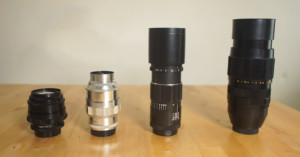
Photographer’s Powerful Images From the End of the Brutal Gulag System
The Gulags were a repressive system of forced labor camps in the Soviet Union that cost the lives of millions of people.

The Gulags were a repressive system of forced labor camps in the Soviet Union that cost the lives of millions of people.

Photographer Helga Paris, who captured daily life in Soviet Union-occupied East Berlin, has died at the age of 85.

The first photo of the Chernobyl disaster taken 14 hours after the nuclear catastrophe went viral yesterday along with the fascinating story behind it.

An urban explorer photographer was arrested and put in an Albanian jail for nine months.

This mind-bending World War II photograph with "floating trees" may look like it is an optical illusion or cloned on Photoshop -- but it is actually a real image.

There aren't many good photos of Venus, and even fewer have been captured from the planet's surface. Distance alone can't explain the relative lack of pictures of Earth's second-nearest neighbor.

Two photographers risked freezing cold waters to explore a former Soviet labor camp in Estonia that's now partially submerged in a lake.

Australian photographer Dean Sewell spent 15 months in Russia after the breakup of the former USSR. When Russia invaded Ukraine, he was suddenly reminded that he still had more than two dozen undeveloped B&W film rolls from 1996 to 1997.

A pair of Soviet film cameras that were among the first to ever go into space is up for auction and one of the vintage 35mm cameras captured the world's first spacewalk.

During the Cold War, the US enlisted the help of Kodak to create a satellite camera for spying on the Soviet Union. This 4-minute video by CNN is a look at the program and the former Kodak employees who "helped prevent World War III."

Photoshop 1.0 was first released as the Soviet Union was collapsing, but long before the software made photo manipulation easy, Kremlin censors went to extraordinary lengths to touch up history.

It may not be the first place that comes to mind, but the Soviet Union is a great place to start if you're looking for a good quality piece of glass on the cheap.... well, what's left of the Soviet Union anyway.

Duga-3 is a radar system set up by the Soviet Union in the 1970s as part of the nation's anti-ballistic missile early warning system. Although official operations were ended in 1989, the gigantic antenna of the original Duga-3 still dominates the countryside near Chernobyl, Ukraine.
Photographer Peter Franc recently traveled to Ukraine to see and photograph the radio transmitter.

Rebecca Litchfield is a photographer who has faced radiation exposure risks, arrest and interrogations, and even accusations of espionage... all for the sake of her project "Soviet Ghosts."
You see, Litchfield is an avid urban explorer who has been fascinated by scenes of decay found in countries that were formerly part of the USSR and the Eastern Bloc.

It turns out that the sharing of images taken by orbiters and rovers in space may have more of a purpose than just being cool to look at. According to a NASA press release published last Thursday, a group of amateur Russian space enthusiasts may have found a missing soviet Mars lander using nothing more than images from NASA's Mars Reconnaissance Orbiter.

After the dissolution of the Soviet Union in 1991, photographer Alexey Titarenko observed how St. Petersburg streets that used to be lively and filled with joyful people had suddenly turned dark and gloomy, with people confused, malnourished, and worn out. He decided to capture this change by shooting the streets at slow shutter speeds, turning the downtrodden crowds into shadowy figures. He titled the resulting project "City of Shadows".